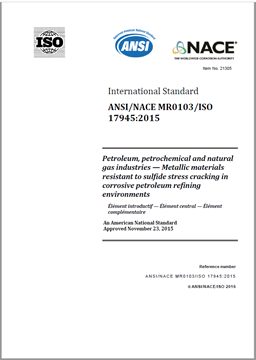Search
Products tagged with 'stress corrosion cracking'
View as
Sort by
Display
per page
A Statistical Analysis of the Gamma Exponent Model; a New Methodology for Corrosion Assessment of Localized Metal Loss Flaws and Stress Corrosion Cracking in Oil and Gas Pipelines
Product Number:
51321-16368-SG
Publication Date:
2021
$20.00
Advancement in Asset Integrity Management through Digitalized Eddy Current Testing Technology for Corrosion Cracking Inspections
Product Number:
51323-19049-SG
Publication Date:
2023
$20.00
Alloy 182 Models for the Prediction of the Susceptibility to SCC of BMI Nozzle J-welds
Product Number:
ED22-17286-SG
Publication Date:
2022
$20.00
Ammonia Stress Corrosion Cracking of Admiralty Brass Heat Exchanger Tubes in Refinery Cooling Water System
Product Number:
51324-20970-SG
Publication Date:
2024
$40.00
ANSI/NACE MR0103-2015/ISO 17945-2015, “Petroleum, petrochemical and natural gas industries -- Metallic materials resistant to sulfide stress cracking in corrosive petroleum refining environments”
Product Number:
21305-SG
Publication Date:
2015
$180.00
Assessing Environmentally Assisted Cracking Of Structural Alloys In Molten Salts
Product Number:
ED22-17120-SG
Publication Date:
2022
$20.00
Characterization of Stress-Corrosion-Cracking in Plutonium-Bearing Storage Containers
Product Number:
51324-20845-SG
Publication Date:
2024
$40.00
Chemical Treatment To Mitigate Polythionic Acid SCC Without A Soda-Ash Wash: Laboratory And Plant Experience
Product Number:
51322-17993-SG
Publication Date:
2022
$20.00
Cold Spray for Repair of Nuclear Reactor System Components
Product Number:
ED22-17267-SG
Publication Date:
2022
$20.00
Corrosion Behavior Of Welded Austenitic Stainless Steels In Coastal Atmospheric Environment
Product Number:
ED22-18359-SG
Publication Date:
2022
$20.00
Cracking Behavior Of Decommissioned Baffle Plates In Light Water Reactor Environment
Product Number:
ED22-17301-SG
Publication Date:
2022
$20.00
Deadleg Stress Corrosion Cracking Risks in SS Piping Systems in Refining and Renewable Units
Product Number:
51324-20816-SG
Publication Date:
2024
$40.00












